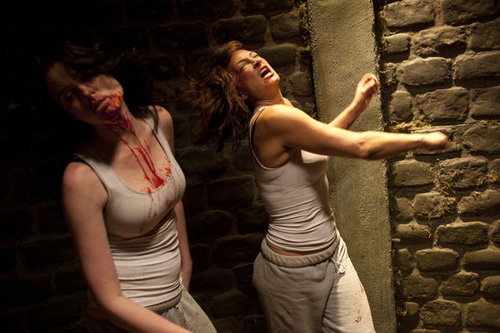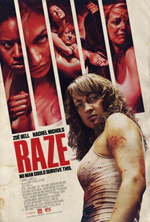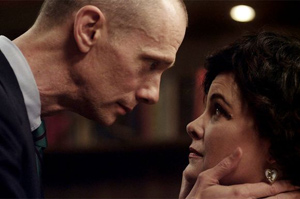 |
|
At The Picture Show
|
January 2014
Raze



What a wicked game we play
'Raze' wears its influences on its sleeve, but can't bring them to life

Raze
IFC Midnight
Director: Josh C. Waller
Screenplay: Robert Beaucage, Kenny Gage and Josh C. Waller
Starring: Zoë Bell, Rebecca Marshall, Doug Jones, Sherilyn Fenn, Tracie Thoms, Bruce Thomas, Rachel Nichols and Bailey Anne Borders
Not rated / 1 hour, 27 minutes
Now playing in limited release and VOD

 (out of four)
(out of four)
At first it seems like a coincidence, with the women from the second half of Quentin Tarantino's Death Proof reuniting in Josh C. Waller's Raze. (Well, three of them, anyway - Mary Elizabeth Winstead couldn't make it.) As QT's thrill-seeking leading ladies take center stage - Zoë Bell and Tracie Thoms in central roles, with Rosario Dawson showing up for a one-scene cameo - we can maybe write it off as a casting quirk.
But then the third act of the film rolls around, and we realize the casting choices are no coincidence at all. With 20 minutes to go, Raze mutates from a bleak, grungy fight movie into a bright and bloody Tarantinian revenge fantasy. Bell - who was Uma Thurman's stunt double in the Kill Bill series - finds herself cast once again as a doppelgänger for The Bride, this time with new forms of cutlery to slice her way through her enemies.
The similarities are made explicitly clear, from the shots focusing on her bare feet as she makes her way across the floor, to the low, tilted angle of Bell's character, Sabrina, face and body bloodied, staring down at her prey in defiance. The whole sequence is practically an homage to Tarantino's filmmaking style - notably the House of Blue Leaves sequence from Volume 1, albeit shorter and less elaborate. And no yellow jumpsuit.
And don't worry - I'm not giving away any secret details. From the first 10 minutes, we know that Sabrina will be our protagonist; and from the very premise - in which women are imprisoned and forced to fight, hand to hand, to the death, until one victor is left standing - we can gather that eventually at least one of them will attempt to turn the tables. That's how this type of movie goes. Otherwise it would just be 90 minutes of women beating each other to death and nothing else.
While we rarely venture outside the walls of the dungeon-like prison where the women are kept, we see enough to know that this nasty little competition - an annual event, if I remember correctly - is put on for the enjoyment of a small class of wealthy elites, and organized by the husband-and-wife team of Joseph (Doug Jones) and Elizabeth (Sherilyn Fenn).
 The two have quite the elaborate production going on, targeting and surveilling potential candidates (and their loved ones) before eventually kidnaping them. All that personal information makes for a handy bit of coercion. How are the women forced to fight? Easy. If you lose a fight, they kill your child. Or your parent. Or your brother or sister. Or your wife. For Sabrina, it's the daughter she gave up for adoption more than a decade ago.
The two have quite the elaborate production going on, targeting and surveilling potential candidates (and their loved ones) before eventually kidnaping them. All that personal information makes for a handy bit of coercion. How are the women forced to fight? Easy. If you lose a fight, they kill your child. Or your parent. Or your brother or sister. Or your wife. For Sabrina, it's the daughter she gave up for adoption more than a decade ago.
Yet the central conceit is hardly used for any further means. The film presents an idea rife with potential for commentary and satire - capitalistic exploitation, exploitation of women, sexualization of violence, or even the concept of violence as sport in general - but plays it strangely straightforward. Victims down below fighting to the death; spectators up top enjoying the show, cheering their favorites on; the guards sadistically reveling the whole thing.
But Waller and his co-writers never throw any weight behind it, which strikes me as a waste of the concept. And if it's not going to have any bite to it thematically, the least it could do is have a little fun - only it doesn't do that, either. Its first hour or so is ugly, nasty and unrelenting as we see fight after fight end in death - soggy flesh thrown around against brick walls, limbs cracked, faces caved in. (Curiously, the victors - while their knuckles get bloodied up - never seem to break any bones or tear any muscles.)
I brought up the Tarantino influence to point out that only in the climactic 20 minutes does Raze find any particular angle to its violence or its set-up. But when it does, it's completely at odds with the rest of the movie. It goes from grimly self-serious to high-spirited and playful.
The second part of that equation works a whole lot better than the first. The fights in the pit below are well-choreographed but often terribly executed, the harsh and frenzied editing style disrupting any sense of rhythm. The third act - with more visual space to work with (we're no longer closed in by the brick walls and oppressive shadows down below) - offers a completely different approach. If there was some of that attitude and style for the entire movie, Raze may have made for a nice old-school exploitation movie. Instead, it seems like it's trying to be two different movies, with the monotonous and unpleasant one overwhelming the rest.
Read more by Chris Bellamy